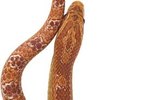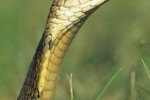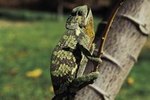
While humans may go through great efforts to mask their outward signs of aging, bull snakes, also known as gopher snakes and pine snakes, display few physical characteristics that reveal their stages of maturity. Unless your pet bull snake was obtained from a breeder who can furnish the hatching date, estimating the snake’s age is an exercise in guesswork based primarily upon his or her size and symmetry.
Size Does Matter
Bull snakes measure an average of one foot in length when hatched, and rapid growth takes place during their first three years of life. The growth rate slows dramatically after that, but never ceases throughout the lifespan of the snake. By three years of age, adults measure an average of five feet long, and they can reach between six and nine feet over the course of their lifetimes. In the wild, bull snakes live for an average of 12 to 15 years, but their lifespans can double in captivity. Older snakes will not only present longer measurements, but their girth will be wider as well, due to the continual growth of their skeletal structure. This is also evidenced by a larger size of the head.
Reproductive Maturity
Bull snakes reproduce annually. Breeding season usually occurs between the months of June and August, and some females will lay two clutches of eggs. Males attain reproductive maturity between one and two years of age, while females are not sexually mature until between three and five years. Males and females do not interact outside of mating season. The behavior displayed in their interaction during mating season reveals whether or not the snakes have reached sexual maturity. The female attracts the male with pheromones that are secreted from her skin during mating season. Signs of mating include combative behavior between the two, the male rubbing the length of his body over that of the female, and the male may also bite the neck of the female.
Eating for Growth or Maintenance?
Bull snakes’ feeding habits change as they mature. Younger snakes will gladly dine at least once weekly, and their smaller size dictates consumption of smaller prey. Very young snakes may insist in killing and eating live prey, but they should be encouraged to accept killed prey. Adult snakes take their meals less frequently, and they take in larger prey to accommodate and satiate their own larger size. Feeding only once every other week is not uncommon for adult bull snakes. Once a female has reached sexual maturity, she may temporarily exhibit either an increase or a decrease in her appetite during mating season.
The Reptile Specialist Knows Best
If you acquired your bull snake from a pet shop or from the wild, a visit to the veterinarian may be the best option for estimating the age and maturity of your pet. An exotics specialist whose area of expertise focuses on reptiles offers the experience that he has gained by examining these animals exclusively. His trained eye will enable him to assess the length and symmetry of your bull snake. All newly acquired snakes should receive a basic physical examination from a reptile specialist, who can estimate age, confirm gender, determine your snake's present health status and provide valuable information regarding the husbandry, nutrition and preventative care of your pet.
References
Photo Credits
-
NA/PhotoObjects.net/Getty Images




